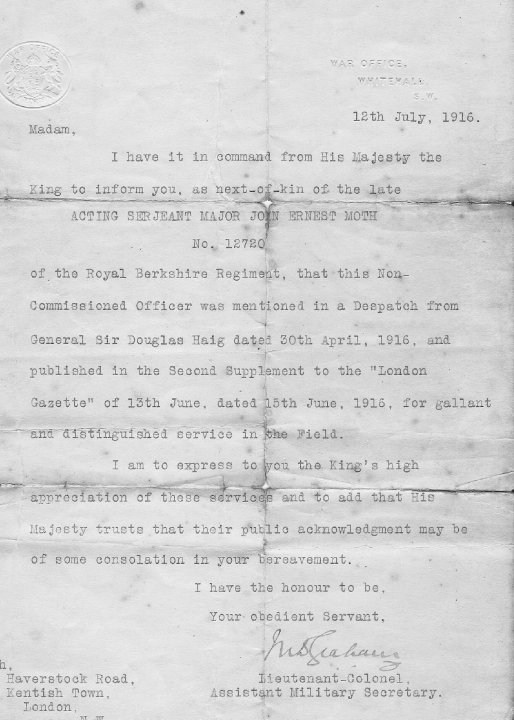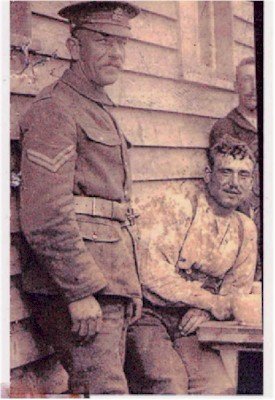
Although we know that John was a member of the Royal Berkshire Regiment, we do not have any official service records as these were lost due to the bombing of the War Office repository in Arnside Street, London in WW2. And, although we cannot be sure of his individual movements before the Battle of Loos, I can at least trace the movements of his Battalion, which was part of the New Army, or more often called, Kitchener’s Army.
The first use in a major action of the New Army units came in August 1915 at Suvla Bay during the Gallipoli Campaign, and also at the Battle of Loos (September–October 1915). The new Battalions had titles in the form of ‘**th (Service) Battalion’, followed by the Regiment name. John’s was named 8th (Service) Battalion, Princess Charlotte of Wales’s (Royal Berkshire) Regiment, and was formed at Reading in September 1914 as part of the Third New Army (K3) and was attached to the 26th Division. Kitchener’s New Army was actually made up of five Army Groups (K1 to K5) and each Army Group contained six Divisions.
John’s Battalion initially moved to Salisbury Plain (Bulford Camp), then back to Reading in November, before moving to Sutton Veny in May 1915. In August 1915, the troops of the 26th Division at Sutton Veny were mobilised for war and crossed the English Channel to Le Havre aboard R.M.S. Viper.
They then transferred to the 1st Brigade of the 1st Infantry Division, which was originally called the '1st (Guards) Brigade' because it contained the 1st Battalions of the Coldstream Guards and the Scots Guards. When the Guards Division was created in August 1915 and these two Battalions departed (both for the 2nd Guards Brigade), the brigade was renamed as 1st Brigade.
The following is a report of the action of Grandad’s Battalion in the 1st Brigade, 1st Division (bear in mind that this is just a small section of the Front):
The 1st Division, which was on the left-hand of the line, began to advance a few minutes late, after casualties were suffered from the British gas which had drifted back into the assault trenches. German machine guns and heavy rifle fire played across the lines of advancing troops.
The 10th Battalion Gloucester’s along with the 8th Battalion Royal Berkshires, advanced through all objectives despite heavy casualties. By 8.00am they were in Gun Trench, an intermediate line running South of the Hulluch quarries. The Regular support battalion, the Cameron Highlanders, pressed the advance on towards Hulluch.
They waited for the 2nd Brigade to come up on their right; but the 2nd Brigade had met with the same devastating fire as the 1st Brigade, and was held up, with a large number of men lying out in the open, close under the German wire. Additional forces were ordered up in support. A direct frontal attack by the 1/14th London Regiment (London Scottish) and 1/9th King’s at Lone Tree met with a hail of close-range bullets, and many men were hit. 2/Royal Munster Fusiliers, also coming up in support, found the trenches near Le Rutoire so full of dead and wounded that they had to advance above ground, and were virtually annihilated.
The attack had effectively halted. Regimental Serjeant Major Lainsbury rallied about 60 men and fought his way through to the village of Hulluch, organising as he advanced, parties for the supply of ammunition. Though Hulluch bristled with enemy guns, the 8th Royal Berkshires actually seized some of the houses in the western suburbs. Hand to hand fighting took place and the enemy yielded ground whenever the Berkshires could come within reach of them. But again and again, the Berkshires were swept back by a tempest of bullets. (RSM Lainsbury was later awarded the Distinguished Conduct Medal for his actions).
The Battle of Loos lasted from September 25th to October 13th 1915. October 9th – 13th: Sporadic fighting continues all along the Front line. In preparation for a new Allied offensive, over 3,000 fresh gas cylinders are installed in forward positions, although only 1,100 are actually discharged when the offensive resumes on the 13th.
We do not know what happened to our Grandfather as his body was never recovered.
An index card from the International Committee for the Red Cross showed that his wife Emily had requested the Red Cross to ascertain if he was a prisoner of war after he went missing (Disparu depuis: ‘disappeared’, or ‘gone since’) on 13th October (1915). Unfortunately, it shows there was a negative reply sent (Negatif envoye) on 7th December which indicated that he had been killed in action.
A letter to Emily shows he was Mentioned in Despatches for ‘gallant and distinguished service in the field’. The assumption has always been that this was for his actions on October 13th, but the entry in the London Gazette does not have ‘killed’ beside his entry, so it may well be that he got his ‘mention’ for an earlier action (between September 25th & October 13th); but this will remain unknown as Mentioned in Despatches never gave actual details of the circumstances.
John is shown as a Corporal early on (obviously his initial rank after training), but then in different documents as ' Corporal/Acting Serjeant', and later as 'Corporal/Acting Serjeant Major'. From this, we can assume that he got two field promotions, first to Serjeant, then Serjeant Major.
Field promotions occurred when the next-in-command above you was injured or killed, and the position needs filling immediately to keep the chain of command intact. This obviously means that someone below him was promoted to his old rank of Corporal, then Serjeant. These field promotions came without any extra pay unless they were later made permanent.
Dud Corner Cemetery stands almost on the site of a German strong point; the Lens Road Redoubt, captured by the 15th (Scottish) Division on the first day of the battle. The name "Dud Corner" is believed to be due to the large number of unexploded enemy shells found in the neighbourhood after the Armistice.
The Loos Memorial commemorates over 20,000 officers and men who have no known grave (including Serjeant Moth J.E.), who fell in the area from the River Lys to the old southern boundary of the First Army, east and west of Grenay, from the first day of the Battle of Loos to the end of the war.
John left a widow and four sons.




